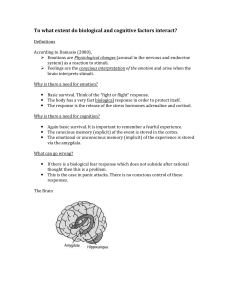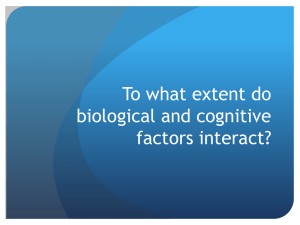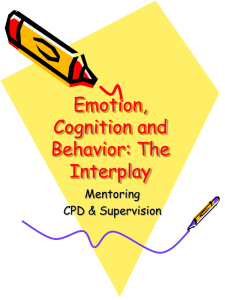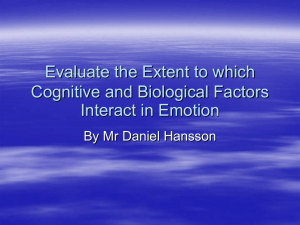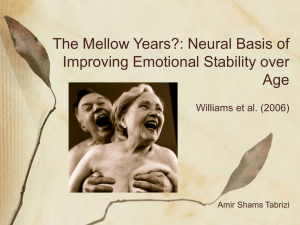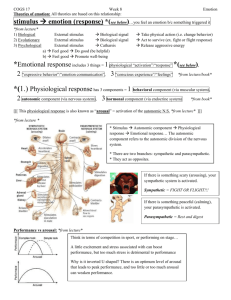Cognition and emotion
advertisement
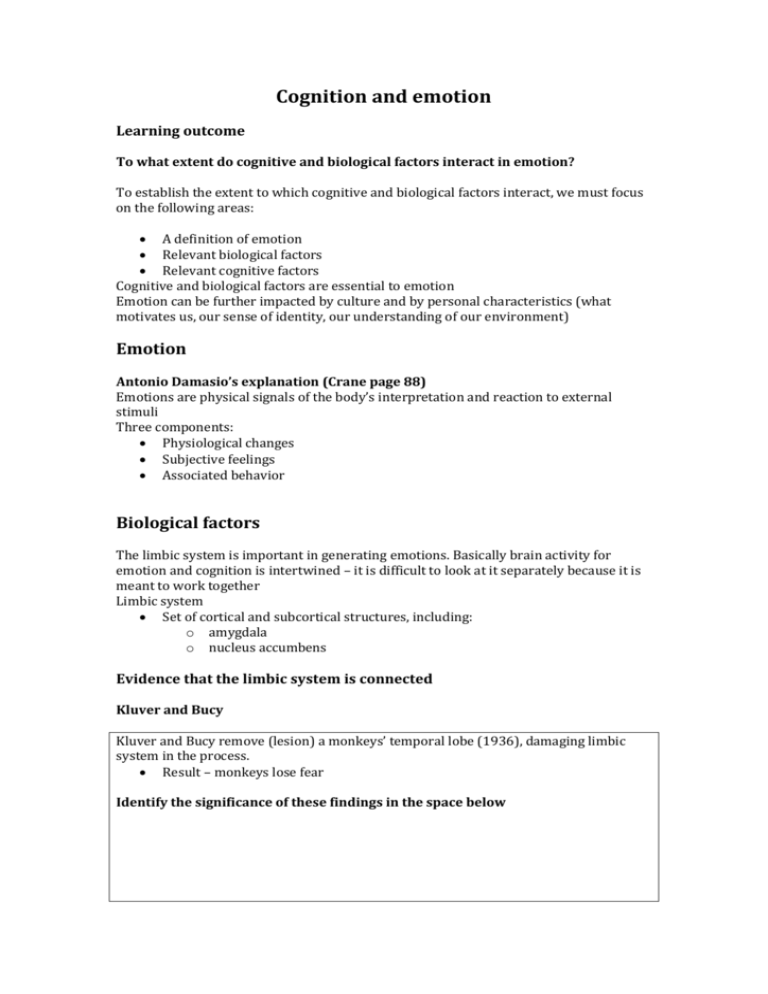
Cognition and emotion Learning outcome To what extent do cognitive and biological factors interact in emotion? To establish the extent to which cognitive and biological factors interact, we must focus on the following areas: A definition of emotion Relevant biological factors Relevant cognitive factors Cognitive and biological factors are essential to emotion Emotion can be further impacted by culture and by personal characteristics (what motivates us, our sense of identity, our understanding of our environment) Emotion Antonio Damasio’s explanation (Crane page 88) Emotions are physical signals of the body’s interpretation and reaction to external stimuli Three components: Physiological changes Subjective feelings Associated behavior Biological factors The limbic system is important in generating emotions. Basically brain activity for emotion and cognition is intertwined – it is difficult to look at it separately because it is meant to work together Limbic system Set of cortical and subcortical structures, including: o amygdala o nucleus accumbens Evidence that the limbic system is connected Kluver and Bucy Kluver and Bucy remove (lesion) a monkeys’ temporal lobe (1936), damaging limbic system in the process. Result – monkeys lose fear Identify the significance of these findings in the space below Olds and Milner Olds and Milner implant electrodes in rats’ brains Aim: to see how rats respond to direct electrical stimulation Findings: when limbic system is stimulated, rats will return to the part of the cage where the experiment took place rat will choose stimulation over food, when allowed to self-stimulate Identify the significance of these findings in the space below Evidence that the amygdala is specifically connected Downer (1961) Researchers operate on monkeys Information entering monkey’s left eye is transmitted to the amygdala Information entering monkey’s right eye will not go through amygdala Findings: See threat with left eye – fear response See threat with right eye – no fear response Identify the significance of these findings in the space below Biological pathways to emotion LeDoux’s model of 2 biological pathways in the brain (Use Schacter et. al. and Crane page 89) Diagram the fast pathway in the space below Diagram the slow pathway in the space below Role of each pathway Purpose of the fast pathway Purpose of the slow pathway Significance What is the significance of LeDoux’s work in terms of the interaction of biological and cognitive factors? Theories about how emotional experience and physical activity are related. Sources Schacter and Singer (handouts) In the boxes below, summarize each of the theories from your reading. Your notes should identify key points, and make it clear how the theories are different. James – Lange theory A stimulus causes a physiological reaction - leads to an emotional experience Cannon-Bard theory A stimulus causes both an emotional experience and a physiological reaction simultaneously Schacter and Singer’s 2-factor theory A stimulus causes general physiological arousal The brain will interpret or make inferences about the cause This will lead to an emotional experience (a subjective feeling) Localization of function Emotions are not specifically localized purely in one section of the brain. Research indicates that brain activity for emotion involves many areas of the brain working both together and in sequence Jamison’s summary of the roles played in the emotion of fear by the amygdala and insula is one example. This example also establishes a sociocultural connection in that fears can be learned. Another example is that of panic disorder. In panic disorder there is increased noradrenaline transmission from both the locus coeruleus (a nucleus in the brain stem) and another area - the caudal raphe nuclei. (see image on the next page) The locus coeruleus is one of the brainstem nuclei that maintains close communications with the amygdala. This small nucleus contains almost half of all the brain neurons that use norepinephrine as a neurotransmitter. The locus coeruleus also projects its axons to those parts of the brain that may be associated with panic disorders (the amygdala, hippocampus, septum, cortex, brainstem, reticular formation, etc). The locus coeruleus-noradrenaline system may have a significant role in processing fear-related stimuli or it may affect fear-related processing by stimulating other regions of the brain implicated in anxiety and fear behaviours (ie amygdala, hippocampus, hypothalamus, cortex and spinal cord). http://www.cnsforum.com/imagebank/item/Neuro_path_N_PAN/default.aspx Other biological factors Obviously we must also take into account the role of neurotransmitters in terms of how messages are passed from one area of the brain to another. Neurotransmitters When we are calm, the "firing" of neurons in the locus caeruleus is minimal. Once a stimulus is perceived, the following will take place: Stimulus perceived sensory cortex thalamus brain stem increases the rate of noradrenergic activity in the locus caeruleus person becomes alert and attentive to the environment (if you go to the site below you can follow these pathways further) http://www.cnsforum.com/imagebank/item/Neuro_path_N_PAN/default.aspx Fight or Flight : An acute stress response If the stimulus is perceived as a threat (message relayed from thalamus to the amygdala) - Neural firing intensifies - Sympathetic nervous system kicks in (Stage 1 of GAS – General Adaptation syndrome – a model explaining stress) Neurotransmitters - Acetylcholine is released - This in turn triggers the release of adrenaline and norepinephrine The physical reaction includes: - Increased heart rate and breathing - Tightening of muscles - Constricted blood vessels How does this help you understand the learning outcome? It gives you the big picture, establishing the complexity of the biological factors. LeDoux gives us a model to explain how the message is relayed which establishes also that cognitive processing takes place. Whether or not the stimulus is perceived as a threat, in the case of fear, will determine whether or not the flight or fight response will kick in. keep in mind that this is not just related to fear. Such a response can also be triggered in times of stress. Let’s examine theories about how appraisal (what directs our perception of a stimuli) works. Cognitive Appraisal Theories of Emotion As cognitive theories have developed over time (from James-Lange to Cannon-Bard and so on), they have become more complex in their explanations of the connection between emotion and behavior Appraisal In the absence of physiological arousal, we decide what to feel after interpreting or explaining what has just happened. Two things are important in this: whether we interpret the event as good or bad for us, and what we believe is the cause of the event. The sequence thus is as follows: Event ==> thinking ==> Simultaneous arousal and emotion This challenges the two-factor separation of arousal and emotion, supporting the Cannon and Bard theory albeit with the addition of the thinking step. In primary appraisal, we consider how the situation affects our personal well-being. In secondary appraisal we consider how we might cope with the situation. This is sometimes also called Lazarus Theory. Example When a colleague gets promoted, I might feel resentful if I think I deserve the promotion more than they do. http://changingminds.org/explanations/theories/cognitive_appraisal_theories.htm Lazarus’ theory of appraisal Stimulus event takes place Brain evaluates or appraises the event Appraisal is related to how the situation impacts on the individual (Crane, page 90) Summarize the following from your reading of Crane: Definition of appraisal Lazarus’ theory (1st paragraph) Lazarus and Folkman’s theory of factors that impact on whether an individual experiences stress (1984) Lazarus and Folkman’s research on which strategies people tend to use in stressful situations Cognitive connection How can appraisal affect how people cope with emotional arousal? The Speisman et al. study (1964) in Crane (p. 90) demonstrates that soundtracks can affect how we react emotionally to an unpleasant film Briefly summarize the study If we know that environmental factors can affect our emotions, can we use cognitive strategies to influence our emotional responses? Now read ‘Regulation of emotion’ – see the next page Define emotion regulation Define reappraisal In what way does the Lazarus & Alfert study support the Speisman et al. study? In what way does the Ochsner et al. study (2002) suggest that we can influence our brain activity to lower activity in our amygdalae (plural for ‘amygdala’)? How is this significant to our understanding of the learning outcome?

